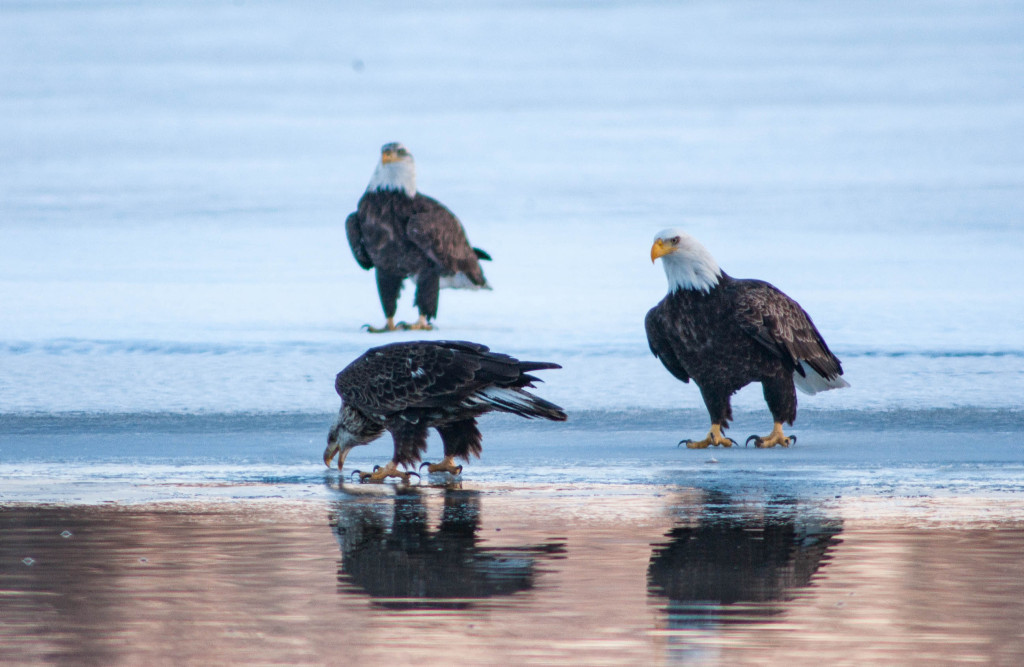
By Olivia DaRugna, Watchable Wildlife Biologist
Is there an animal more majestic than the bald eagle? A once-endangered bird due to insecticides, including DDT, and hunting, bald eagles have rebounded and are now flourishing across the country. They represent one of America’s greatest conservation success stories.
In Nebraska, bald eagles can be observed year round, but arguably, winter offers the best opportunities for viewing these large birds of prey. Large concentrations of bald eagles arrive in winter to hunt for fish and ducks in the open waters of rivers and large reservoirs. Their keen eyesight, large talons and elegant hunting strategies make them a fascinating bird to watch.
Most people can identify the iconic adult bald eagle. However, young birds don’t grow bright white heads and tail feathers and brown body plumage until they are about 5 years old. Juvenile bald eagles (1-4 years old) have variable amounts of brown with white speckling. They are often mistaken for golden eagles. However, juvenile bald eagles have distinct white “armpits,” white mottling all over, and are typically found near water, whereas golden eagles are found in open prairies or escarpments in the western half of Nebraska.
Where to Observe Bald Eagles
Visit areas where there is open water for the best eagle-viewing opportunities. Parks along the Platte and Missouri rivers can offer excellent chances to view eagles perched in trees, standing on ice and hunting. Visit river overlooks at Niobrara, Ponca and Indian Cave state parks as well as Gavin’s Point Dam, Desoto National Wildlife Refuge and Lewis & Clark Visitor Center. For more information about these locations, check out the interactive map on the Nebraska Birding Guide website. While watching the bald eagles, you may even see them harass and steal fish from each other.
In February and March, as ice starts to break up on larger waterbodies, bald eagles may concentrate to feed on exposed dead fish and newly arrived, migrating waterfowl. Visit Branched Oak State Recreation Area and look for bald eagles perched in large trees adjacent to the lake. If you see large flocks of waterfowl take off from the water, look closely for a bald eagle flying overhead. Eagles often spook large rafts of ducks on the water that fly away in a frenzy to avoid becoming the raptor’s next meal.
Even if you don’t enjoy going out in the cold, you can still enjoy spectacular eagle concentrations from the warmth of two eagle viewing facilities operated by the Central Nebraska Public Power and Irrigation District. The Kingsley Dam eagle viewing facility is just below Lake McConaughy in Ogallala SRA, and the J-2 Facility is just south of Lexington. Both facilities are open on weekends through the end of February, but check their website for hours and more details. These viewing facilities are great for the whole family to enjoy these spectacular birds while staying cozy indoors. Whether you consider yourself a birder or just an outdoor enthusiast, you can’t help but be in awe when an adult eagle swoops down and plucks a fish from the frigid waters.
Wildlife Viewing Events this month
The Great Backyard Bird Count is Feb. 17-20. You can participate in this global event from the comfort of your own home. Just identify and count the birds in your yard and submit the data through eBird.
Check out the Outdoor Calendar for more events happening across the state.
